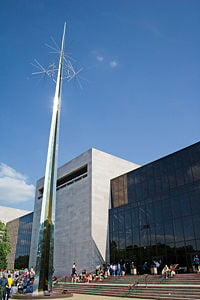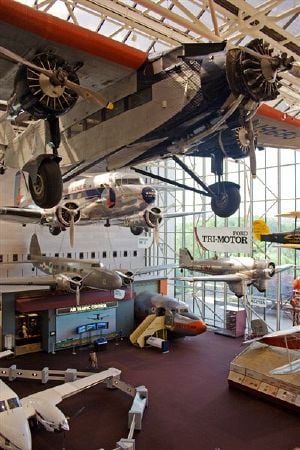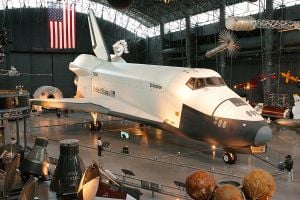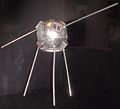National Air and Space Museum
| Established | July 1, 1976 |
|---|---|
| Location | Washington, D.C. |
| Visitor figures | 5,023,565 (2006) |
| Director | Gen. John R. Dailey |
| Curator | Tom Crouch |
| Public transit access | L'Enfant Plaza (Washington Metro) Maryland Avenue exit. |
| Website | http://www.nasm.si.edu/ |
The National Air and Space Museum (NASM) of the Smithsonian Institution is a museum in Washington, D.C., United States, and is the most popular of the Smithsonian museums. It maintains the largest collection of aircraft and spacecraft in the world. It is also a vital center for research in the fields of the history, science, and technology of aviation and spaceflight, as well as planetary science and terrestrial geology and geophysics. Almost all space and aircraft on display are originals or backup crafts to the originals.
The Museum's collections display marvelous technological achievements that impress all visitors. The glory of aviation and space technology, however, is often overshadowed by its ties to the tragic human history of war. Although the Museum focuses on the scientific and technological value of its collections, aviation technology cannot be easily dissociated from the social, political realities of human history. In 1994, for example, the Museum planned to exhibit the Enola Gay, the B-29 bomber which dropped atomic bomb on Hiroshima City, Japan. The technological success of this "experimental" bomb was accompanied with one hundred forty thousand instantaneous civilian casualties (Modern warfare, as a political measure, targets combatants and avoids indiscriminate killings of non-combatants. Because the atomic bomb and terrorists are outside of the modern concept of warfare, they raise questions regarding the ethics of war.) and painful lasting side effects incurred on the survivors. The controversy that erupted led to the resignation of the Museum director. The incident demonstrates how technology cannot be separated from the moral values that guide the development and responsible use of technology for the benefit of humanity.
History
Originally called the National Air Museum when it was formed on August 12, 1946, by an act of Congress,[1] some pieces in the National Air and Space Museum collection date back to the 1876 Centennial Exposition in Philadelphia, after which the Chinese Imperial Commission donated a group of kites to the Smithsonian. The Stringfellow steam engine intended for aircraft was accessioned into the collection in 1889, the first piece actively acquired by the Smithsonian now in the current NASM collection.
After the establishment of the museum, there was no one building that could hold all the items to be displayed. Some pieces were on display in the Arts and Industries Building, some were stored in a shed in the Smithsonian's South Yard that came to be known as the "Air and Space Building," and the larger missiles and rockets were displayed outdoors in "Rocket Row."
The combination of the large numbers of aircraft donated to the Smithsonian after World War II and the need for hangar and factory space for the Korean War drove the Smithsonian to look for its own facility to store and restore aircraft. The current Garber Facility was ceded to the Smithsonian by the Maryland-National Capital Park and Planning Commission in 1952, after the curator Paul E. Garber spotted the wooded area from the air. Bulldozers from Fort Belvoir and prefabricated buildings from the United States Navy kept the initial costs low.
The space race in the 1950s and 1960s led to the renaming of the Museum to the "National Air and Space Museum," and finally congressional passage of appropriations for the construction of the new exhibition hall, which opened July 1, 1976, at the height of the United States Bicentennial festivities.
The Steven F. Udvar-Hazy Center opened in 2003, funded by a private donation.
Carl W. Mitman was the first head of the museum, under the title of Assistant to the Secretary for the National Air Museum, heading the museum from 1946 until his retirement from the Smithsonian in 1952.[2]
As of July 2008, the National Air and Space Museum is staffed by about two hundred sixty employees and about five hundred volunteers.
Architecture
The National Air and Space Museum is widely considered one of Washington's most significant works of modern architecture. Because of the museum site's close proximity to the United States Capitol, the Smithsonian Institution wanted a building that would be architecturally impressive but would not stand out too boldly against the Capitol Building. St. Louis-based architect Gyo Obata of Hellmuth, Obata and Kassabaum accepted the challenge and designed the museum as four simple travertine-encased cubes containing the smaller and more theatrical exhibits, connected by three spacious steel-and-glass atriums which house the larger exhibits such as missiles, airplanes, and spacecraft. The museum, built by Gilbane Building Company, was finished in 1976. The west glass wall of the building is used for the installation of airplanes, functioning as a giant door.
Mission statement
The National Air and Space Museum has impressive collections of the original aircrafts, spacecrafts, and items that illustrate the development of aviation history. Each collection is a remarkable footstep and technological achievement of human history. The museum's commitment of preservation, research, and education to the public is reflected in its mission statement.
The National Air and Space Museum shall commemorate the national development of aviation and spaceflight, and will educate and inspire the nation by:
- Preserving and displaying aeronautical and spaceflight equipment and data of historical interest and significance to the progress of aviation and spaceflight
- Developing educational materials and conducting programs to increase the public's understanding of, and involvement in, the development of aviation and spaceflight
- Conducting and disseminating new research in the study of aviation and spaceflight and their related technologies.[3]
Collection and facilities
The central atrium of the NASM is the "Milestones of Flight" exhibit. Some of the most important artifacts of the aerospace history of the United States hang there, or sit on the floor of the atrium.
Hanging from the rafters
- The North American X-15, a rocket plane used for hypersonic flight research.
- A replica of Pioneer 10 (actually the functional Pioneer H), the first space probe launched on a trajectory to escape the solar system, and the first to visit Jupiter.
- The Spirit of St. Louis, in which Charles Lindbergh made the first solo flight across the Atlantic Ocean.
- SpaceShipOne, the world's first privately built and piloted vehicle to reach space, designed by Burt Rutan and built by his company, Scaled Composites.
- Voyager, a Burt Rutan-designed plane in which Burt's brother Dick Rutan and Jeana Yeager made the first non-stop non-refueled circumnavigation of Earth.
- The Bell X-1 Glamorous Glennis, in which Chuck Yeager made the first powered supersonic level flight.
- A model of Mariner 2, the first probe to successfully fly by another planet (Venus).
- The Bell XP-59 Airacomet, the first viable American jet aircraft
On the atrium floor
- A model of Robert H. Goddard's original 1926 liquid-fueled rocket
- The command module of Apollo 11, the first mission to land astronauts on the moon
- A model of the Viking 1 lander, the first probe to successfully land on the surface of Mars
- The gondola of the Breitling Orbiter 3, the first balloon to circumnavigate the Earth nonstop
- The Friendship 7 capsule, in which John Glenn became the first American to orbit Earth
- One of the very few lunar rock samples accessible to the public
- The Gemini 4 capsule, which carried America's first spacewalker, Ed White
- An American Pershing missile and a Soviet SS-20 missile
Other selected exhibits
- The original Wright Flyer that made the first controlled, powered flight in 1903
- A German V-2 rocket constructed from captured components, the first man-made object to reach space
- A rock from Mars (a meteorite)
- The original filming model of the starship USS Enterprise from the science fiction television series Star Trek
- The television camera of Surveyor 3, which was brought back from the moon by Apollo 12
- A backup copy of Skylab, America's first space station
- The Northrop M2-F3, a lifting body that was a precursor to the Space Shuttle Orbiter
- A model of one of the Voyager probes, which famously explored all of the solar system's gas giants in the 1980s
- Models of the full Apollo CSM, Soyuz spacecraft and docking module from the Apollo-Soyuz Test Project, all connected as the real articles were in orbit
The National Air and Space Museum has 50,000 artifacts and thousands of additional artifacts come at different parts of the year.
Dulles International Airport Annex
The museum has a larger annex, the Steven F. Udvar-Hazy Center, located near Dulles Airport, which opened on December 15, 2003. Its plans call for a collection of 900 aircraft[4] with 135 spacecraft on display. The center was made possible by a US$ 65 million gift in October 1999 to the Smithsonian Institution by Steven F. Udvar-Hazy, an immigrant from Hungary and co-founder of the International Lease Finance Corporation.[4] Construction of the Center required fifteen years of preparation.[5]
Select exhibits
- The B-29 Superfortress bomber Enola Gay, the airplane which dropped the first atomic bomb, on Hiroshima, Japan
- The prototype for the Boeing 707 airliner, known as the Boeing 367-80 or Dash 80
- An SR-71 Blackbird high-altitude, high-speed strategic reconnaissance aircraft
- An Air France Concorde, the famous model of supersonic airliner
- The prototype atmospheric test space shuttle Enterprise
- The primary special effects miniature of the "Mother Ship" used in the filming of Close Encounters of the Third Kind
- The Virgin Atlantic GlobalFlyer, the aircraft which completed the first solo, non-stop, unrefueled circumnavigation of the Earth in early 2005
Restoration facility
The museum's total collection numbers over 30,000 aviation-related and 9,000 space-related artifacts, and is thus larger than will fit in the main hall. Many of the aircraft are at the Paul E. Garber Preservation, Restoration, and Storage Facility, also sometimes referred to as the "Silver Hill facility," in Suitland-Silver Hill, Maryland. The facility was acquired by the Smithsonian Institution in 1952, as a storage location for the growing collection of aircraft. It is named for Paul E. Garber, former curator of the collection, and it consists of 32 buildings.
The facility once was open for touring, but all exhibition items are being moved to the museum annex.
Other facilities
The Museum's archives are divided between the main exhibition building on the Mall and the Garber facility in Suitland. The collections include personal and professional papers, corporate records, and other collections assembled by topic.
The Museum includes the Center for Earth and Planetary Studies (CEPS), which conducts geological and geophysical research related to all the planets in the solar system. CEPS participates in programs that involve remote-sensing satellites and unmanned probes.
The museum also has a research library, at the site of the main museum building.
Controversies
The collections, which include warplanes and military devices, often impress visitors for their technological achievements, but at the same time they raise ethical and moral questions. Controversy erupted in 1994, over a proposed exhibit commemorating the atomic bombing of Japan on its 50th anniversary. The centerpiece of the exhibit was the Enola Gay, the B-29 bomber that dropped the A-bomb on the Japanese city of Hiroshima. Veterans’ groups, backed by some Congressmen, argued strongly that the exhibit’s inclusion of Japanese accounts and photographs of victims insulted airmen.[6] Also disputed was the predicted number of fatal U.S. casualties that would have resulted from an invasion of Japan, had that been necessary. In the end, the museum’s director, Martin O. Harwit, was led to resignation.
Scientific clarity
Throughout the museum's displays, the Air and Space Museum presents all thrust levels for rocket and jet engines in mass units (kilograms or pounds) rather than force units (newtons or pounds-force). This usage is at odds with common scientific/engineering practice presented in NASA SP 7012.
Images
See also
Notes
- ↑ National Air and Space Museum, National Air and Space Museum—NASM Chronology. Retrieved August 1, 2008.
- ↑ Finding Aids to Official Records of the Smithsonian Institution, Record Unit 330: Series 1, National Air and Space Museum, Records, 1912-1971. Retrieved August 28.
- ↑ National Air and Space Museum, Mission Statement. Retrieved July 31, 2008.
- ↑ 4.0 4.1 L.M. Small, A century's roar and buzz: Thanks to an immigrant's generosity, the Steven F. Udvar-Hazy Center opens to the public, in "From the Secretary," Smithsonian Vol. 34: 20.
- ↑ W. Triplett, "Hold everything!" Smithsonian Vol. 34 (2003): 59.
- ↑ Los Angeles Times, Head of Air, Space Museum Quits Over Enola Gay Exhibit. Retrieved July 31, 2008.
ReferencesISBN links support NWE through referral fees
- Bryan, C.D.B. The National Air and Space Museum. New York: H.N. Abrams, 1979. ISBN 9780810906662.
- Henderson, Mary. Star Wars: The Magic of Myth. New York: Bantam, 1997. Retrieved July 31, 2008.
- Head of Air, Space Museum Quits Over Enola Gay Exhibit. Los Angeles Times. May 3, 1995. Retrieved August 28, 2008.
- Small, L. M. "A century's roar and buzz: Thanks to an immigrant's generosity, the Steven F. Udvar-Hazy Center opens to the public." "From the Secretary." Smithsonian. Vol. 34, December 2003.
- Triplett, W. "Hold everything!" Smithsonian. Vol. 34, December 2003.
External links
All links retrieved November 10, 2022.
| |||||
Credits
New World Encyclopedia writers and editors rewrote and completed the Wikipedia article in accordance with New World Encyclopedia standards. This article abides by terms of the Creative Commons CC-by-sa 3.0 License (CC-by-sa), which may be used and disseminated with proper attribution. Credit is due under the terms of this license that can reference both the New World Encyclopedia contributors and the selfless volunteer contributors of the Wikimedia Foundation. To cite this article click here for a list of acceptable citing formats.The history of earlier contributions by wikipedians is accessible to researchers here:
The history of this article since it was imported to New World Encyclopedia:
Note: Some restrictions may apply to use of individual images which are separately licensed.
















